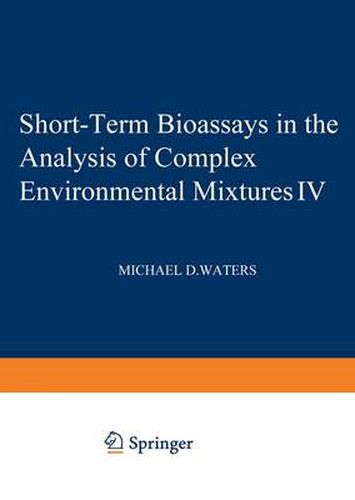Readings Newsletter
Become a Readings Member to make your shopping experience even easier.
Sign in or sign up for free!
You’re not far away from qualifying for FREE standard shipping within Australia
You’ve qualified for FREE standard shipping within Australia
The cart is loading…






This title is printed to order. This book may have been self-published. If so, we cannot guarantee the quality of the content. In the main most books will have gone through the editing process however some may not. We therefore suggest that you be aware of this before ordering this book. If in doubt check either the author or publisher’s details as we are unable to accept any returns unless they are faulty. Please contact us if you have any questions.
With this proceedings of the fourth symposium on complex mixtures, we continue to revise and extend our knowledge of genetic methods for the evaluation of chemical mixtures in the environment. The early chapters of this volume are devoted to new bioassay techniques that are directly applicable to the monitoring of environments contaminated with genotoxic chemicals. Microbiological methods have been further refined to meet the special needs of atmospheric monitoring so that very small samples may now be efficiently tested. New in situ methods utilizing green plants actually avoid many of the usual difficulties of sample collection and preparation and offer special advantages in monitoring wastewater, sludges, and hazardous wastes. Insects also are being employed very effectively in the evaluation of gaseous air pollutants in controlled laboratory investigations. Increased emphasis has been placed on a comprehensive assessment of the potential of complex mixtures t9 cause various kinds of genetic damage. New assays for chromosome structural and numerical aberrations in mammalian cells in vitro have been developed and are being applied in laboratory studies. Efforts to link tests for gene mutation and cell transformation in vitro with assays for tumorigenesis in vivo are contributing to the validation of the short-term testing approach. Studies comparing in vitro and in vivo data on a coal conversion by-product, on polycyclic aromatic hydrocarbons, and on mineral fibers are reported in separate papers. Later chapters are devoted to investigations on the fractionation and biological evaluation of specific chemical components within complex mixtures.
$9.00 standard shipping within Australia
FREE standard shipping within Australia for orders over $100.00
Express & International shipping calculated at checkout
Stock availability can be subject to change without notice. We recommend calling the shop or contacting our online team to check availability of low stock items. Please see our Shopping Online page for more details.
This title is printed to order. This book may have been self-published. If so, we cannot guarantee the quality of the content. In the main most books will have gone through the editing process however some may not. We therefore suggest that you be aware of this before ordering this book. If in doubt check either the author or publisher’s details as we are unable to accept any returns unless they are faulty. Please contact us if you have any questions.
With this proceedings of the fourth symposium on complex mixtures, we continue to revise and extend our knowledge of genetic methods for the evaluation of chemical mixtures in the environment. The early chapters of this volume are devoted to new bioassay techniques that are directly applicable to the monitoring of environments contaminated with genotoxic chemicals. Microbiological methods have been further refined to meet the special needs of atmospheric monitoring so that very small samples may now be efficiently tested. New in situ methods utilizing green plants actually avoid many of the usual difficulties of sample collection and preparation and offer special advantages in monitoring wastewater, sludges, and hazardous wastes. Insects also are being employed very effectively in the evaluation of gaseous air pollutants in controlled laboratory investigations. Increased emphasis has been placed on a comprehensive assessment of the potential of complex mixtures t9 cause various kinds of genetic damage. New assays for chromosome structural and numerical aberrations in mammalian cells in vitro have been developed and are being applied in laboratory studies. Efforts to link tests for gene mutation and cell transformation in vitro with assays for tumorigenesis in vivo are contributing to the validation of the short-term testing approach. Studies comparing in vitro and in vivo data on a coal conversion by-product, on polycyclic aromatic hydrocarbons, and on mineral fibers are reported in separate papers. Later chapters are devoted to investigations on the fractionation and biological evaluation of specific chemical components within complex mixtures.